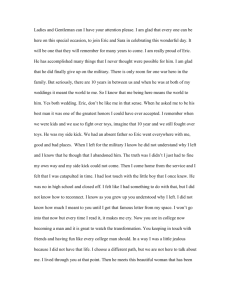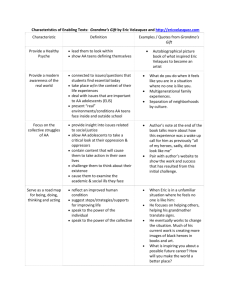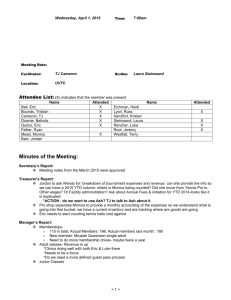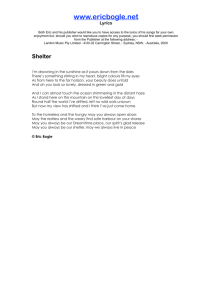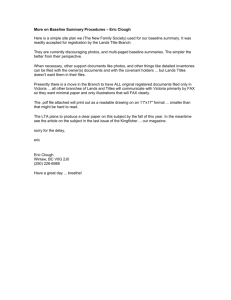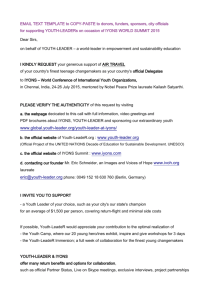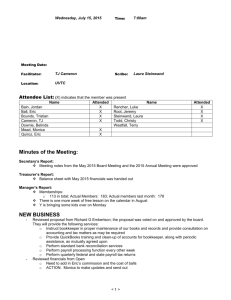Reflective Essay in Education, APA Style (Gibson)
advertisement
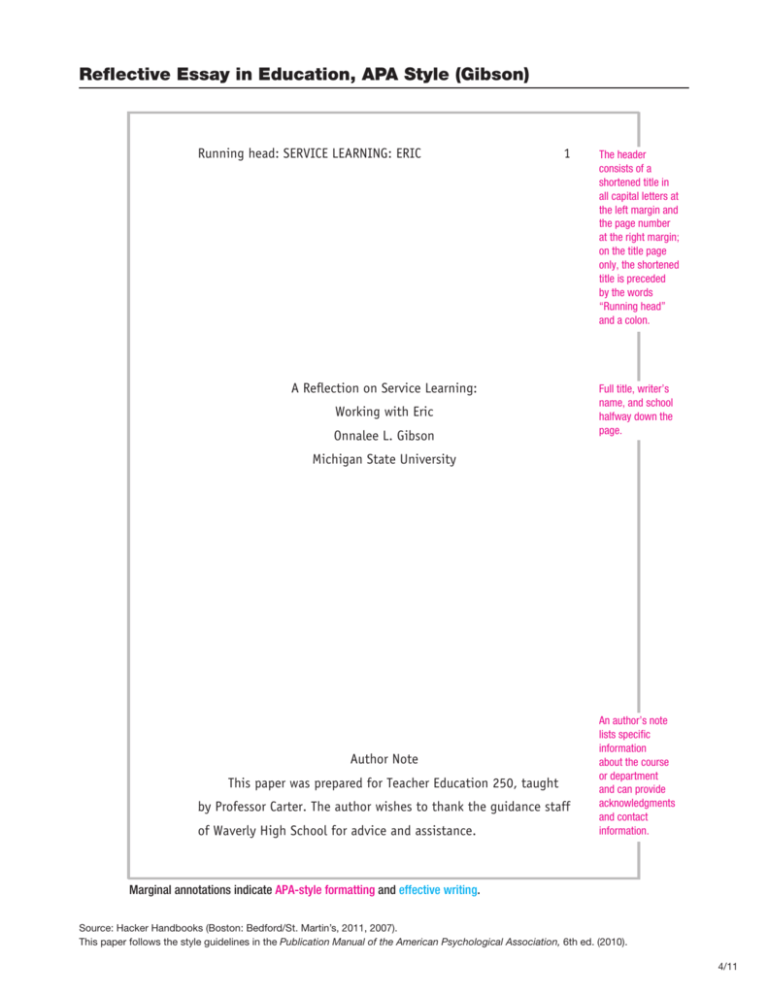
Reflective Essay in Education, APA Style (Gibson) Running head: SERVICE LEARNING: ERIC 1 A Reflection on Service Learning: Working with Eric Onnalee L. Gibson The header consists of a shortened title in all capital letters at the left margin and the page number at the right margin; on the title page only, the shortened title is preceded by the words “Running head” and a colon. Full title, writer’s name, and school halfway down the page. Michigan State University Author Note This paper was prepared for Teacher Education 250, taught by Professor Carter. The author wishes to thank the guidance staff of Waverly High School for advice and assistance. An author’s note lists specific information about the course or department and can provide acknowledgments and contact information. Marginal annotations indicate APA-style formatting and effective writing. Source: Hacker Handbooks (Boston: Bedford/St. Martin’s, 2011, 2007). This paper follows the style guidelines in the Publication Manual of the American Psychological Association, 6th ed. (2010). 4/11 SERVICE LEARNING: ERIC 2 A Reflection on Service Learning: Working with Eric The first time I saw the beautiful yet simple architecture of Waverly High School, I was enchanted. I remember driving by while exploring my new surroundings as a transfer student to Michigan State University and marveling at the long front wall of reflective windows, the shapely bushes, and the general Reflective essays may include descriptive passages. cleanliness of the school grounds. When I was assigned to do a service learning project in a local school district, I hoped for the opportunity to find out what it would be like to work at a school like Waverly—a school where the attention to its students’ needs was evident from the outside in. Waverly High School, which currently enrolls about 1,100 students in grades 9 through 12 and has a teaching staff of 63, is Background information about the school sets the scene for Gibson’s personal experiences. extremely diverse in several ways. Economically, students range from poverty level to affluent. Numerous ethnic and racial groups are represented. And in terms of achievement, the student body boasts an assortment of talents and abilities. The school provides a curriculum that strives to meet the needs of each student and uses a unique grade reporting system that itemizes each aspect of a student’s grade. The system allows both teachers and parents to see where academic achievement and academic problems surface. Unlike most schools, which evaluate students on subjects in one number or letter grade, Waverly has a report card that lists individual grades for tests, homework, exams, papers, projects, participation, community service, and attendance. Thus, if a student is doing every homework Source: Hacker Handbooks (Boston: Bedford/St. Martin’s, 2011, 2007). SERVICE LEARNING: ERIC 3 assignment and is still failing tests, this breakdown of the grades may effectively highlight how the student can be helped. It was this unique way of evaluating students that led to my first meeting with Eric Johnson, an 11th grader to whom I was assigned as a tutor. Eric is an African American male who grew up in a nuclear middle-class family in a Lansing suburb. Teachers noticed Transition leads from background information about the school to Gibson’s personal experiences. over time that Eric’s grades were dropping, yet his attendance, participation, and motivation were above average. Surprisingly, Eric himself was the one who asked for a tutor to help him raise his grades. What initially struck me about Eric was the level of responsibility he seemed to take for his own academic achievement. At the time I wrote in my journal (January 31, 2006), “He appears to be a good student. He is trying his best to succeed in school. He came to me for help and realizes the need for a tutor.” While tutoring Eric, I paid attention to the way he talked about his classes and to the types of assignments he was being Journal entries are considered personal communi­ cation and are cited in the text but not included in the reference list. asked to complete. My impression was that Waverly High School was fostering student success by doing more than just placing posters in the hallways. Waverly’s curriculum encourages analytical thinking, requires group and individual projects that depend on creativity and research, and includes open-ended writing assignments designed to give students opportunities to form their own conclusions. I found this reality both difficult and inspiring; I had not expected an 11th grader’s homework to be so challenging. I once said so to Eric, and he responded with a smile: “Yeah. My teachers say it’s going to help us when we get to college to already know how to do some of these things.” What was surprising to me Source: Hacker Handbooks (Boston: Bedford/St. Martin’s, 2011, 2007). Personal observa­ tions lead to broader insights. SERVICE LEARNING: ERIC was the faculty’s collective assumption that high school was not the end of a student’s career. The fact that teachers talk with students about what will be expected when (not if) they go to college is significant. That kind of positive language, which I heard many times at Waverly, most certainly affects students’ Gibson analyzes her evidence to draw a broader conclusion. sense of themselves as achievers. In this case, Eric was not preoccupied with worrying about whether he wanted to go to college or would be accepted; rather, he mentally prepared himself for the time when he would actually enroll. This section bridges academic theory and personal experience. According to education researcher Jean Anyon (1981), “Students from higher social class backgrounds may be exposed to legal, medical, or managerial knowledge . . . while those of the working classes may be offered a more ‘practical’ curriculum” (p. 5). I do not see this gravitation toward social reproduction holding true for most students at Waverly High School. Waverly’s student body is a mix of social classes, yet the school’s philosophy is to push each of its students to consider college. Through its curriculum, its guidance department literature, and its opportunities for career field trips, Waverly is opening doors for all of its students. In Eric’s case, I also observed the beginnings of a break in social reproduction. From the start of our tutoring sessions, Eric frequently mentioned that neither of his parents went to college (Gibson, journal entry, March 14, 2006). This made me wonder how his parents talk to him about college. Is the desire to go to college something they have instilled in him? Have they given him the message that if he works hard and goes to college he will be successful? If that is Source: Hacker Handbooks (Boston: Bedford/St. Martin’s, 2011, 2007). 4 SERVICE LEARNING: ERIC 5 the case, then Eric’s parents are attempting to break the cycle with their children—and they have the good fortune to live in a school district that supports their desires. In contrast to the idea that most people have nothing more than social reproduction to thank for their socioeconomic status (Bowles & Gintis, 1976), Eric seems to believe that hard work and a college education are keys Source is cited in APA in-text citation style. to his success. Another key to Eric’s success will be the resources he enjoys as a student at Waverly. Abundance of or lack of resources can play an important part in students’ opportunities to learn and succeed. Because nearly half of all school funding comes from local property taxes (D. Carter, class lecture, April 4, 2006), areas with smaller populations or low property values do not have the tax base to fund schools well. As a result, one education finance expert has Class lecture (personal commu­ n­i­cation) is cited in the text only, not in the reference list. argued, some children receive substandard education (Parrish, 2002). Waverly does not appear to have serious financial or funding issues. Each student has access to current textbooks, up-todate computer labs, a well-stocked library, a full art and music curriculum, and numerous extracurricular activities. While countless schools are in desperate need of a better-equipped library, Waverly’s library has a rich collection of books, magazines and journals, computer stations, and spaces in which to use all of these materials. It is a very user-friendly library. This has shown me what the power of funding can do for a school. Part of Waverly’s (and its students’) success results from the ample resources spent on staff and curriculum materials. Adequate school funding is one of the factors that drive school and student success. Source: Hacker Handbooks (Boston: Bedford/St. Martin’s, 2011, 2007). Gibson considers the larger implications of her personal observations. SERVICE LEARNING: ERIC 6 Aside from funding, placement policies determine school and student success. A major concern of both educators and critics of education policies is that schools will place students into special education programs unnecessarily. Too often students who do not need special education are coded for special ed— even when they have a learning issue that can be handled with a good teacher in a mainstream class (D. Carter, class lecture, April 6, 2006). At Waverly High School, teachers and counselors are not so quick to shuffle Eric into special ed. I agree with several of Eric’s teachers who feel that he may have a mild learning disability. I began to feel this way when Eric and I moved from working in a private tutoring space to working in the library. It was clear to me that he had difficulty paying attention in a public setting. On February 9, I wrote in my journal: Eric was extremely distracted. He couldn’t pay attention to what I was asking, and he couldn’t keep his eyes on his work. There were other students in the library today, and he kept eavesdropping on their conversations and shaking his head when they said things he did not agree with. This is how he must behave in the classroom; he is easily distracted but he wants to work hard. I see that it is not so much that he needs a tutor because he can’t understand what his teachers are telling him; it is more that he needs the one-on-one attention in a confined room free of distractions. Even though Eric showed signs of distraction, I never felt as if he should be coded for special education. I am pleased that the Source: Hacker Handbooks (Boston: Bedford/St. Martin’s, 2011, 2007). SERVICE LEARNING: ERIC 7 administration and learning specialists did not decide to place Eric in a special education track. Eric is exceedingly intelligent and shows promise in every academic area. He seems to be able to succeed by identifying problems on his own and seeking resources to help him solve those problems. He is a motivated and talented student who simply seems like a typical adolescent. I came away from my service learning project with an even stronger conviction about the importance of quality education for a student’s success. Unlike the high school I attended, Waverly pays close attention to each child and thinks about how to get all its students to succeed at their own level. Jean Patrice, an administrator, told me, “You have to be able to reach a student where they are instead of making them come to you. If you don’t, you’ll lose them” (personal communication, April 10, 2006). Patrice expressed her desire to see all students get something out of their educational experience. This feeling is common among members of Waverly’s faculty. With such a positive view of student potential, it is no wonder that 97% of Waverly High School graduates go on to a four-year university (Patrice, 2006). I have no doubt that Eric Johnson will attend college and that he will succeed there. As I look toward my teaching future, I know there is plenty that I have left to learn. Teaching is so much more than getting up in front of a class, reiterating facts, and requiring students to learn a certain amount of material by the end of the year. Teaching is about getting students—one by one—to realize Source: Hacker Handbooks (Boston: Bedford/St. Martin’s, 2011, 2007). SERVICE LEARNING: ERIC Conclusion raises questions for further reflection. and act on their potential. This course and this service learning experience have made me realize that we should never have a trial-and-error attitude about any student’s opportunities and educational quality. Source: Hacker Handbooks (Boston: Bedford/St. Martin’s, 2011, 2007). 8 SERVICE LEARNING: ERIC 9 References Anyon, J. (1981). Social class and school knowledge. Curriculum List of references is in APA style. Inquiry, 11(1), 5. Bowles, S., & Gintis, H. (1976). Schooling in capitalist America: Educational reform and contradictions of economic life. List is alphabetized by authors’ last names. New York, NY: Basic Books. Parrish, T. (2002). Racial disparities in identification, funding, and provision of special education. In D. Losen & G. Orfield (Eds.), Racial inequity in special education. Cambridge, MA: Civil Rights Project and Harvard Education Press. Source: Hacker Handbooks (Boston: Bedford/St. Martin’s, 2011, 2007). Double-spacing is used throughout.
